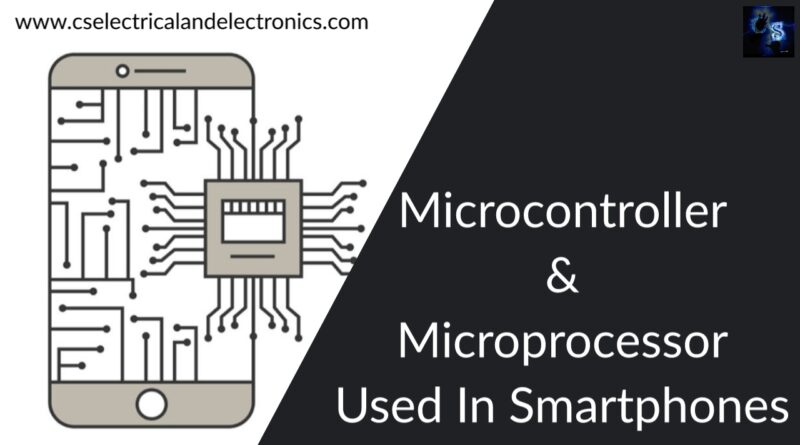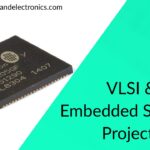Microcontrollers And Microprocessors Used in SmartPhones Or Mobiles
Hello guys, welcome back to my blog. In this article, I will discuss the microcontrollers and microprocessors used in smartphones or mobiles, ARM introduction, features of ARM, etc.
If you have any doubts related to electrical, electronics, and computer science, then ask questions. You can also catch me on Instagram – Chetan Shidling.
Also, read:
- Top 15 Applications of Embedded Systems, Embedded System Application
- Applications Of IoT, Internet Of Things, What Is IoT, Latest Technology
- Types Of Sensors Used In Mobile Phones, Sensors Used In Android Phones
Microcontrollers And Microprocessors Used in SmartPhones
Microcontrollers are tiny chips that serve as the brains of Embedded Systems and regulate their operations. The need for microcontrollers has grown over time, resulting in technological advancement. A memory, CPU, and peripherals make up a microcontroller. Microcontrollers come in a variety of shapes and sizes and are utilized in a variety of products such as consumer goods and smartphones.
The growing usage of smartphones and tablets has made it easier for people to connect to the outside world. Users who often use such devices should be familiar with the word ARM, as it refers to the hardware that these devices employ. When compared to laptops or desktops, it has a slight variation in usage.
Introduction to ARM Microcontrollers
The term ARM stands for Advanced RISC Machine, with RISC standing for Reduced Instruction Set Computing. RISC architectures are used in all ARM processors. ARM is a popularly recognized architecture that treats all of its designs as a single-family and updates them over time with new version numbers.
Features of ARM Microcontrollers
The RISC architecture used by ARM microcontrollers allows for compact implementations while utilizing less power and increasing performance. There are several more essential characteristics of ARM that make it one of the most popular gadgets. Let’s have a look at the features:
- It is made up of big register files that are all the same size.
- It is based on a store architecture, in which data processing is performed on register content rather than directly interacting with memory information.
- It deals with the auto-increment and auto-decrement modes, which aid in the optimization of program loops.
- It optimizes the use of the Arithmetic Logic Unit and shifter during data processing instructions by controlling the ALU and shifter.
The ARM7 microcontroller is one of the types of microcontrollers that helps devices function more efficiently, increasing user confidence in the gadget. ARM7 is used by several companies in their products to improve functionality and provide best-in-class services.
Microcontrollers based on the ARM7 architecture, as well as ARM7 itself, have a bright future ahead of them, as the use of smartphones and other mobile devices continues to grow. Candidates that understand the ins and outs of ARM7 will be given more opportunities than their counterparts. Choosing the ARM7 online training course might be beneficial for those who want to have a thorough knowledge of the ideas.
Different smartphone manufacturers utilize different microprocessors in their devices. In reality, various functional units like graphics, USB, WiFi, and so on are all combined into a single chip, which is known as a mobile processor SOC (System on Chip).
The following are some of the most common mobile CPU SOCs found in various smartphones:
01. Qualcomm Snapdragon:
This is still a popular chip that can be found in phones from Google Pixel, Motorola, LG, Asus, Oneplus, HTC, and other manufacturers. Snapdragon processors are built entirely by Qualcomm and are based on the ARM architecture.
Snapdragon processor cores employed three versions of microarchitecture: Scorpion (until 2008), Krait (from Snapdragon 400 to 805), and the most recent Kryo, which is an ARMv8-based 64-bit CPU core. This is found in the Snapdragon 820 processor, which is used in the majority of today’s high-end smartphones.
02. Apple A series:
For usage in iPhones, Apple builds application processors in-house based on ARM architectures. The A9 (used in the iPhone 6) and A10 Fusion SOCs are the most recent (used in iPhone 7).
03. Samsung Exynos:
Samsung Exynos is a line of CPU SOCs that are utilized in their devices. Until Exynos 7, the SOC relied on ARM CPU core IP (Cortex series like A53, A73). The newer Exynos 8 does, however, have a Mongoose core, which was created and built in-house by Samsung.
The latest Samsung Galaxy S7 phone came in two flavors: one with a Mongoose-based Exynos CPU and another with a Snapdragon 820 processor.
04. Huawei Kirin series:
Huawei’s Honor smartphones all feature HSilicon-designed CPU SOCs. The Kirin family of CPUs leverages ARM’s core IP, with the most recent – the Kirin 960, an octa-core CPU – including four Cortex A73 and four Cortex A53 processors.
05. Helio series (Helio P and Helio X):
MediaTek’s newest processor SOCs employ ARM’s cortex A53 and cortex A73 cores and are known as the Helio series (Helio P and Helio X). Xiaomi Redmi, Gionee S8, Leco Le2 are just a few of the phones that employ MediaTek CPUs.
Another popular processor that was intended for smartphones was the Intel Atom processors, but that seems to have died down in competition with all of the above processors based on ARM architecture.
To sum up, The sorts of CPUs and controllers, as well as their new generations, that we utilize in our smartphones are detailed above. I hope this article “Microcontrollers And Microprocessors Used in SmartPhones” may help you all a lot. Thank you for reading.
Also, read:
- 100 + Electrical Engineering Projects For Students, Engineers
- 1000+ Electronics Projects For Engineers, Diploma, MTech Students
- 1000+ MATLAB Simulink Projects For MTech, Engineering Students
- 500+ Embedded System Projects For Engineer, Diploma, MTech, PhD
- 500+ Projects For Diploma Electrical, Electronics Student, Diploma Project
- 8051 Microcontroller Timers, TCON Register, TMOD Register
Author Profile
- Content Writer
Latest entries
 All PostsAugust 25, 2021Top 16 Highest Paying Engineering Jobs in the USA For Freshers
All PostsAugust 25, 2021Top 16 Highest Paying Engineering Jobs in the USA For Freshers All PostsAugust 23, 2021Top 10 Smart Cities In The World, Best Cities To Visit In The World
All PostsAugust 23, 2021Top 10 Smart Cities In The World, Best Cities To Visit In The World All PostsAugust 21, 2021Top 20 VLSI & Embedded Systems Projects for Mtech Students
All PostsAugust 21, 2021Top 20 VLSI & Embedded Systems Projects for Mtech Students All PostsAugust 21, 2021Top 20 Power Systems Projects For MTech Students, Engineering Students
All PostsAugust 21, 2021Top 20 Power Systems Projects For MTech Students, Engineering Students








